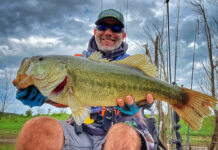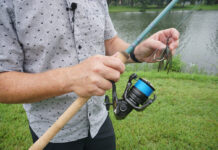Keeping a big fish on the line comes down to a well-tied knot. Learning how to tie fishing line well will result in more fish in the boat. Always remember, the best fishing knot is the knot you tie best. From weights to floats, lures and more, learning a few useful connections will improve your chances of landing a trophy catch.
How to Tie Fishing Line Knots
How to Tie on a Lure
There are many ways to tie a lure to fishing line, but the most common is the uni-knot. Simple, quick and effective, tie it with braided fishing line or monofilament, the uni-knot has many uses.
To tie a uni-knot, pass the line through the eye of the lure and make an overhand loop. Wrap the tag end of the line through the overhand loop five times. Pull the tag end and the mainline to tighten the knot.
The uni knot is one of the best fishing hook knots and it can be used to tie on a lure or connect two pieces of line.

How to Tie Fishing Line Together
To connect two pieces of fishing line, use a double uni knot. Hold the tag ends of each piece of line parallel. With one end, make an overhand loop and run the tag end five times through the loop. Tighten the knot finger tight. Then, make a similar loop with the second end and pull it finger tight. To cinch down the knot, put the tag ends in your teeth and pull on the mainline ends with your hands.
How to Make a Loop in Fishing Line
To add a sinker to your fishing line, add hooks to a bottom rig or clip a leader to a snap swivel, make a loop in the fishing line. The surgeon’s loop is easiest to tie.
Fold the end of the line over itself. Make an overhand loop with the folded over line and pass the end through the loop two times. Hold the loop in one hand and the tag end and mainline in the other and pull against each other to tighten.
How to Put a Weight on a Fishing Line
To get a lure or bait closer to the bottom, anglers add weight to the fishing line. There are many ways to add weight, but the best policy is to use as little weight as possible.

How to Put a Sinker on a Fishing Line
Use a surgeon’s loop to add a sinker to the end of the line. The surgeon’s knot is helpful for making a bottom rig. Tie three surgeon’s loops into three feet of line, each spaced six inches apart. Add a sinker to the bottom loop and a hook to each loop above then tie the top of the rig to your fishing line.
How to Attach a Slip Sinker to a Fishing Line
For a sneakier approach, use a slip sinker. A slip sinker allows the fish to take the bait without feeling the weight of the sinker.
To attach a slip sinker to a fishing line, thread an egg sinker on the mainline. Tie a swivel to the end of the mainline and add a short leader to the hook or lure. For a heavier weight, over two ounces, use a fish finder clip to hold a bank sinker.
How to Attach a Split Shot to Fishing Line
To add a little weight to the line only requires a split shot. Pinch the lead ball to the line a few inches above the hook. A split shot is just heavy enough to hold a bait below a bobber or adjust the depth of a lure drifting in the current.
How to Tie a Fishing Lure to Line
How to Tie a Hook on a Fishing Line
To tie a hook to the line, use the uni knot described above. For a stronger connection, snell the hook to the line. The uni knot can also be used to snell the hook. Pass the line through the hook eye and make a loop with the tag end. Pass the tag end through the loop and around the hook shank five times. Pull the tag end and the mainline to tighten the knot then slide it up the hook shank to the eye.
How to Tie a Chatterbait to a Fishing Line
To tie a chatterbait to fishing line, use an improved clinch knot. Pass the line through the eye of the lure and turn the tag end around the mainline seven times. Pass the tag end through the loop created at the lure eye and pull tight. The improved clinch knot is stronger and more abrasion resistant for use with heavy lures that go through rough structure.
How to Attach a Spoon to a Fishing Line
Spoons are one of the oldest and most effective lures, they twist and turn in the water flashing like a real fish. But, all the twisting and turning can twist and tangle the line. To attach a spoon to the fishing line, start with a snap swivel. Tie the snap swivel to the line and clip the lure to the snap. Or, tie a small swivel between the mainline and an eight-inch length of leader.

How to Attach a Float to Fishing Line
How to Tie a Bobber to a Fishing Line
To keep a bait off the bottom, anglers use a float. A small plastic bobber allows the angler to attach the float anywhere along the line. First, the red side of the float is the top and the white side is the bottom. A bobber has a button with a piece of wire running through it. Push the button and clip the line to the bottom and top of the float. Other types of floats, for larger baits, are thread onto the fishing line and use a small plastic stopper to adjust the depth of the bait.
How to Tie a Popping Cork to a Fishing Line
Popping corks do two jobs, they keep the bait off the bottom and attract fish. A popping cork is a foam float that slides on a piece of wire. The bottom of the float is weighted. Attach the top of the wire to the mainline coming from the reel and the bottom of the wire to a 12 to 18-inch leader and a jig or baited hook.
Cast out the popping cork and let it settle on top of the water. Give the rod tip a hard jerk to cause the cork to pop and splash. Then, let the cork settle and repeat the move. The sound and vibration attracts fish to the bait.
How to Attach a Stick Float to a Fishing Line
A stick float is long and narrow to create less resistance when a fish takes the bait. To use a stick float, pass the mainline through the float and secure it with a bobber stopper.
Other Hardware
How to Set Up Fishing Line with Swivel
A swivel allows the lure to turn without twisting the line and causing a tangle. A swivel also makes it easier to connect two pieces of fishing line or add a piece of wire to a fishing line. Snap swivel allow the angler to change rigs or lures without cutting the line and retying. The best bet is keep swivels and snap swivels as small as possible since they make fish suspicious.

How to Attach Wire Leader to Fishing Line
To attach wire leader, use a swivel and make a haywire twist with the wire.
Pass the end of the wire through the eye of the swivel then turn it around in four tight wraps. Then, end the knot with four parallel barrel loops.
To attach wire directly to the fishing line with an Albright knot. Bend eight inches of wire over on itself. Then, pass the line through the loop and wrap down the loop seven times. Pass the end of the line through the loop and pull tight.
Other Questions
How to Tie a Fishing Line Together
To tie fishing line together, use a uni-knot to uni-knot connection. This knot works with braided line and monofilament or fluorocarbon. For a stronger connection, use an FG knot. This cinch knot wraps the lighter line up the heavier line for double strength. Big game anglers like a Bimini knot to no-name or use a complicated wind-on leader with hollow-core line and heavy mono. An easy knot to tie is the Slim Beauty. Make a loose double overhand knot in the heavier line. Do not fully tighten the overhand knot. Pass the lighter line through both loops of the overhand knot. Then wrap the lighter line 12 to 18 times up the heavier line and bring the tag end back through the first wrap. Pull the wraps down the heavy line, the close off the double hand knot. Then, cinch down the lighter line to make the knot tight.
How to Tie a Knot in Braided Fishing Line
Braided line is slicker than monofilament or fluorocarbon. Use a knot, like a uni-knot or palomar, that will not slip. When tying a knot in braid, make a few extra wraps with the line.
From weights to floats, lures and more, learning a few useful connections will improve your chances of landing a trophy catch. | Feature photo: Maël Balland/Pexels






